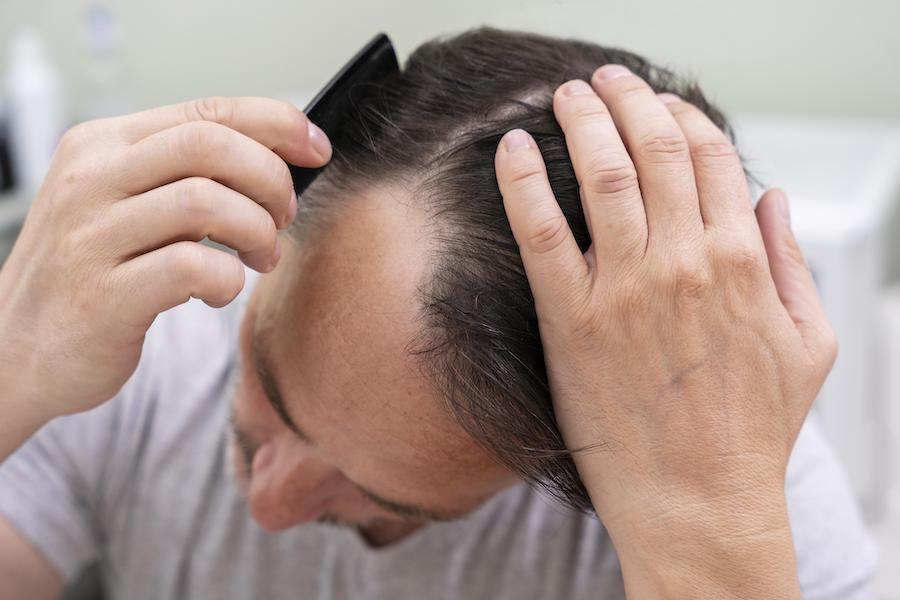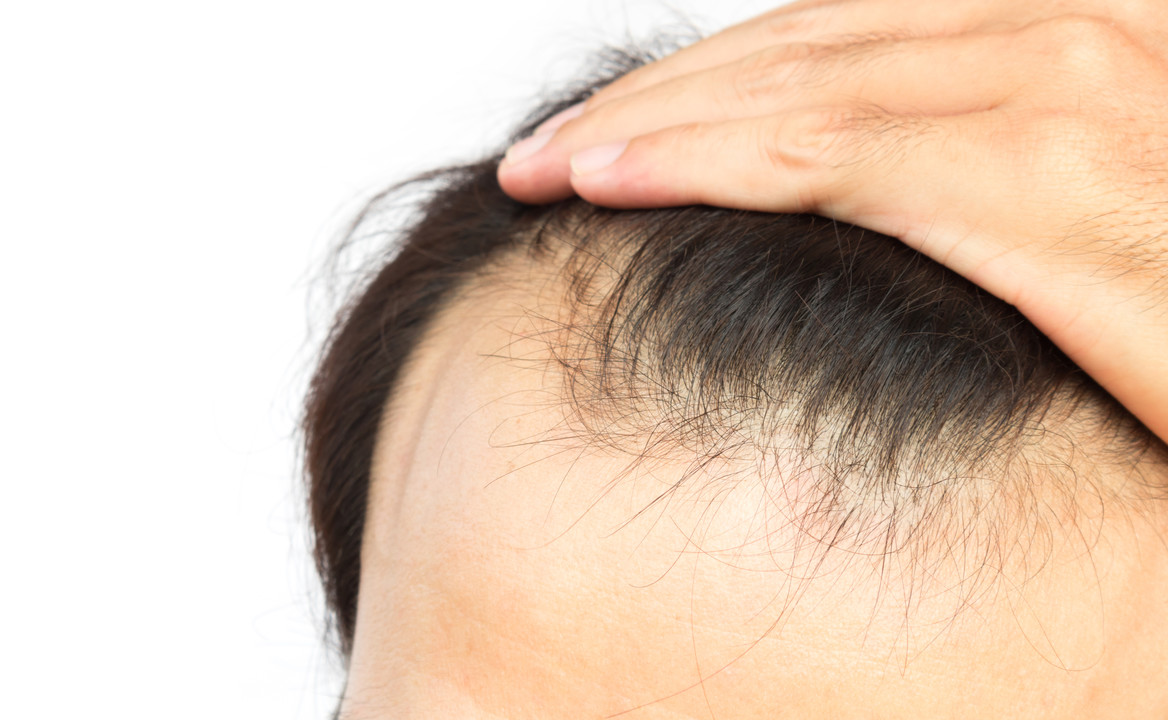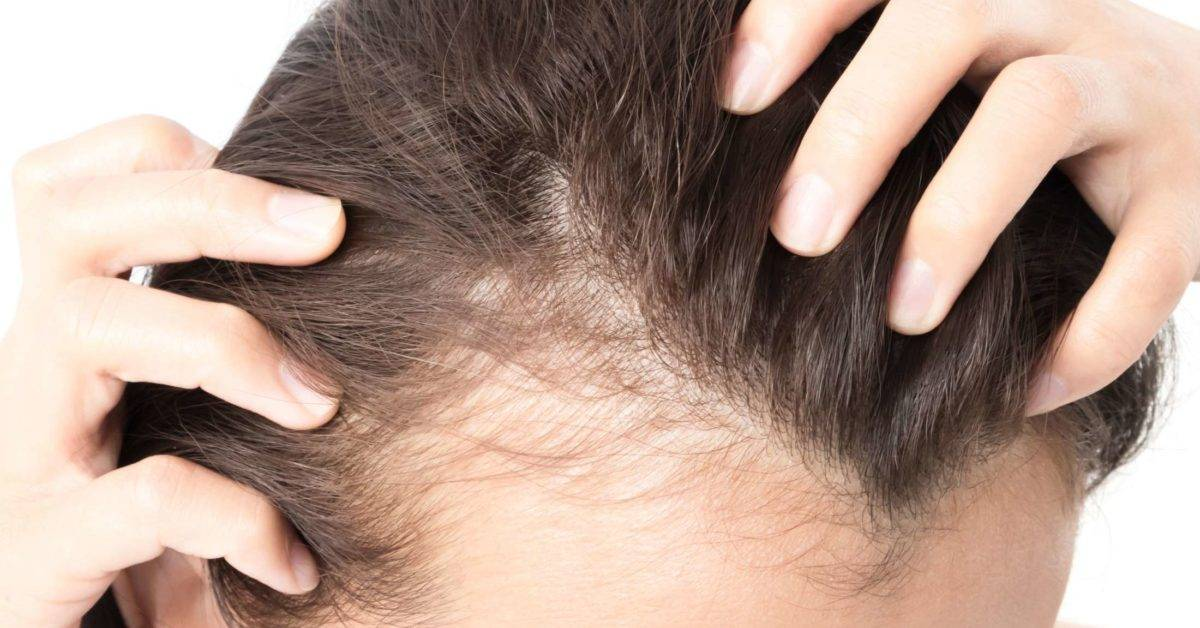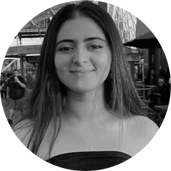Discovering that your hair is thinning on one side can be puzzling and distressing. This unexpected change often leaves many wondering about the root cause and seeking practical solutions.
Hair thinning, especially one-sided, might stem from various reasons, from simple lifestyle factors to more complex health conditions.
Understanding these causes is the first step towards addressing the issue. Fortunately, several effective solutions are available that can help manage and, in some cases, reverse this condition.
In this article, we'll dive into the common causes of one-sided hair thinning and explore practical ways to restore your hair's health and confidence.
Table of content
What causes hair thinning on one side?

Hair thinning on one side can be attributed to various factors, from physical stress to underlying health conditions. Here's a breakdown of the common causes:
1. Trichotillomania
Trichotillomania is a psychological condition where an individual has an irresistible urge to pull out their hair, leading to noticeable thinning. This habit can cause uneven hair loss, often more pronounced on the side that the person favours during pulling.
Managing this condition usually requires psychological support and therapy.
2. Sleeping On The Same Side of the head
Regularly sleeping on the same side of the head can exert pressure on hair follicles, potentially causing thinning in that area. The constant friction between the hair and the pillow can weaken hair strands and increase shedding, leading to a noticeable difference in hair density on one side of the scalp.
3. Age
Hair naturally begins to thin as we age due to decreased hair follicle activity. This process can sometimes occur unevenly, leading to one side appearing thinner.
Age-related hair thinning is a natural phenomenon influenced by genetics (family history) and hormonal changes.
4. Scalp Conditions
Conditions like psoriasis, dermatitis, or fungal infections can lead to inflamed and scaly scalp areas. These conditions disrupt the hair growth cycle, causing hair thinning or loss in affected areas. If these conditions are more prominent on one side, it can lead to asymmetrical hair thinning.
5. Trauma
Physical trauma to the scalp, such as injuries or surgeries, can damage hair follicles and disrupt hair growth. This can result in localized hair thinning or bald patches. If the trauma is on one side of the scalp, it can cause hair thinning, primarily in that area.
6. Alopecia areata
Alopecia areata is an autoimmune condition that causes round, patchy hair loss that can affect any scalp area.
When these patches appear predominantly on one side, it can give the appearance of uneven hair thinning. This condition can be unpredictable, with hair sometimes regrowing and falling out again.
7. Compound Hairs
Compound hairs, where multiple hair strands grow out of a single follicle, can sometimes lead to uneven hair density.
If this condition is more prevalent on one side of the scalp, it may cause that side to appear fuller or thinner compared to the other, affecting overall hair symmetry.
8. Telogen Effluvium
Telogen effluvium is a temporary condition characterized by excessive hair shedding due to stress, illness, or hormonal changes.
Although it generally affects the entire scalp, it can sometimes manifest more severely on one side, depending on individual hair growth cycles and the distribution of stress factors.
9. Scarring Alopecia
Scarring alopecia refers to conditions that cause permanent hair loss by destroying hair follicles and replacing them with scar tissue.
If scarring occurs more extensively on one side of the scalp, it can lead to uneven hair thinning and loss in that area.
10. Traction Alopecia
Traction alopecia is caused by sustained tension on the hair follicles from tight hairstyles. It can lead to gradual hair thinning and loss, primarily along the hairline and at the sites of tension.
If these hairstyles are worn in a way that exerts more pressure on one side, that side may experience more significant thinning.
As your leading source for hair health information over the past 4 years, we never compromise on accuracy. When it comes to your health, you deserve information you can truly rely on - and earning your trust is our top priority.
Here's how Scandinavian Biolabs ensures every piece of content meets the highest standards of accuracy and integrity:
- Credentialed Experts: Our reviewers are actively practicing doctors and medical researchers
- Stringent Reviews: Content undergoes rigorous editing by subject specialists and review by a practicing doctor.
- Evidence-Based: We rely on well-established research from trusted scientific sources like peer-reviewed journals and health authorities.
- Full Transparency: Our editorial standards, writer credentials, reviewer credentials, correction process, and funding are all publicly documented.
- Independent Voice: While we do promote products, we operate in a vacuum to business operations. Our main goal is just an unwavering commitment to providing medically-sound guidance.
You can count on Scandinavian Biolabs to consistently deliver the trustworthy health information you deserve. Read our Editorial Standards.
How to treat hair thinning on one side
Treating hair thinning on one side involves identifying the underlying cause and adopting appropriate treatments or lifestyle changes. Here are several strategies to address this issue:
1. Bio-Pilixin Serum

When tackling the issue of hair thinning on one side, the Bio-Pilixin Activation Serum emerges as a noteworthy solution. This serum is formulated with a potent mix of scientifically proven ingredients to combat hair loss and promote hair growth.
Capilia Longa, a rich nutrient medium derived from Curcuma longa stem cells, is at the heart of this hair growth serum.
Clinical studies have demonstrated its ability to decrease hair loss by up to 89% and increase hair density by 52%, showcasing its significant impact on hair care.
Niacinamide is another critical component, vital for promoting sustained hair growth. It boosts blood circulation and protects hair follicles from early demise caused by oxidative stress.
This aspect is particularly beneficial for protecting the hair on the thinning side from further damage due to environmental stressors like pollution and UV exposure.
Including Vanillyl Butyl Ether, a mild warming agent, further enhances the serum's effectiveness. It improves blood flow to the scalp, ensuring that vital nutrients and oxygen reach the hair follicles, thus supporting healthy hair growth on the affected side.
Bio-Pilixin Activation Serum is backed by a 150-day money-back guarantee, reflecting the brand's confidence in its product's ability to address hair thinning on one side. This policy allows users to try the product risk-free, providing assurance about its efficacy and quality.
Tailored for those experiencing hair thinning on one side, the serum's hydrating and nourishing properties make it an excellent choice.
Its scientifically backed ingredient blend presents a promising method for managing and improving hair thinning issues on one side of the scalp.
2. Medication
Using certain drugs as hair loss treatment options can help with asymmetrical hair loss. For example:
Finasteride
Finasteride is a prescription medication primarily used to treat male pattern hair loss or baldness at the crown and in the middle of the scalp.
It prevents the body from converting testosterone into dihydrotestosterone (DHT), a hormone known to cause hair follicles to shrink and eventually stop producing hair.
Finasteride can slow hair loss and promote hair growth, with effects becoming noticeable after several months of use. It is typically less effective for hair thinning exclusively on one side, as its action is systemic.
Minoxidil
Minoxidil is an over-the-counter topical treatment that can be used by both men and women experiencing hair thinning. It works by stimulating hair follicles to grow through an unknown mechanism, potentially improving blood flow to the scalp.
Minoxidil is applied directly to the affected area of the scalp daily and can effectively treat hair thinning on one side by promoting hair density and growth. Results may vary and typically take a few months to become evident.
3. Scalp Micropigmentation
Scalp micro-pigmentation (SMP) is a non-invasive cosmetic procedure or hair loss treatment that uses micro-needles to deposit pigment into the scalp.
It creates the appearance of tiny hair follicles or a short buzz-cut hairstyle, helping to camouflage areas of thinning hair or baldness.
SMP can be an effective solution for individuals with hair thinning on one side, offering a cosmetic alternative to create the illusion of a fuller head of hair.
The results are immediate, but touch-ups may be needed to maintain the appearance.
4. PRP (Platelet-Rich Plasma) Therapy
PRP therapy involves injecting a concentration of a patient's own platelets into the scalp to treat hair loss and stimulate hair growth. This treatment is based on the premise that platelets can promote healing and increase blood supply to hair follicles, encouraging them to grow.
PRP therapy can be particularly beneficial for directly addressing hair thinning on one side by targeting the affected area. Multiple sessions are often required to achieve the best results, and improvements can be seen within a few months.
5. Hair Transplant
A hair transplant is a surgical procedure that moves hair from a dense area to a thinning or balding area of the scalp. Techniques like follicular unit transplantation (FUT) and follicular unit extraction (FUE) allow hair transplantation to the thinning side of the head.
This method can provide a permanent solution to hair thinning on one side by redistributing existing hair to balance scalp coverage. Recovery time varies, and the transplanted hair may take several months to grow and blend naturally with the surrounding hair.
Additional tips to treat one-sided hair loss

Treating one-sided hair loss involves a multifaceted approach that combines medical treatments with lifestyle adjustments.
Here are some additional tips to help manage and improve the condition:
- Gentle hair care: Avoid tight hairstyles and minimize the use of heat styling tools to prevent further damage.
- Balanced diet: Eat a diet rich in vitamins, minerals, and proteins essential for hair health.
- Scalp massage: Regularly massage your scalp to improve blood circulation, which can stimulate hair growth.
- Avoid harsh chemicals: Use gentle, sulfate-free shampoos and conditioners to reduce the risk of irritation and damage.
- Stay hydrated: Keeping your body hydrated is crucial for maintaining healthy hair.
- Reduce stress: Engage in stress-reducing activities, as high stress levels can exacerbate hair loss.
- Avoid smoking: Smoking can impair blood circulation to the scalp, negatively affecting hair growth.
- Sun protection: Protect your scalp from sun damage by wearing hats or applying sunscreen to exposed areas.
- Regular check-ups: Visit a dermatologist or trichologist to monitor the health of your scalp and hair.
Can sleeping on one side of your head cause hair loss?

Yes, consistently sleeping on one side of the head can contribute lose hair or thinning in that area. The friction between your hair and the pillowcase and the pressure applied to the hair follicles can lead to mechanical stress and breakage over time. This hair loss is usually temporary and can be mitigated by changing sleep positions or using silk or satin pillowcases to reduce friction.
Is losing hair on one side a sign of male pattern baldness?
Losing hair predominantly on one side is not typically a sign of male or female pattern baldness. Male pattern baldness, also known as androgenetic alopecia, usually manifests as a receding hairline, thinning at the crown, or a widening part, following a more symmetrical pattern.
Hair loss that occurs mainly on one side could be attributed to other factors such as mechanical stress, localized scalp conditions, or other health issues. If you're experiencing one-sided hair loss, it's advisable to consult a healthcare professional for an accurate diagnosis.
Hairstyle for one-sided hair loss
Choosing the right hairstyle can significantly minimize the appearance of one-sided hair loss, enhancing your confidence and overall look. Here are some hairstyle ideas to consider:
Asymmetrical cut
An asymmetrical cut with longer hair on one side can cleverly disguise thinner areas by drawing attention away from the side with less hair. This style is versatile and works well for various hair lengths.
Side-swept bangs
Side-swept bangs can help cover thinning areas at the front or side of the scalp. They add volume and movement, creating a fuller appearance.
Layered styles
Layers can add volume and texture to your hair, making thinning areas less noticeable. A skilled stylist can tailor layered cuts to balance out the appearance of hair density across your scalp.
Short, textured haircuts
Short, textured cuts, such as pixie cuts or short bobs, can reduce the weight on your scalp, making any thinning less obvious. These styles are easy to manage and can make your hair look fuller.
Comb over style
The comb-over style involves brushing hair from one side to the other, covering thinning areas with fuller sections of hair. This can be an effective way to hide hair loss on one side, especially with the help of styling products for added volume.
Conclusion
In conclusion, hair thinning on one side can be caused by various factors, including mechanical stress, health conditions like alopecia areata, traction alopecia, etc., and nutritional deficiencies.
Treatments range from hair regrowth medications like finasteride and minoxidil to procedures such as scalp micro pigmentation, PRP therapy, and hair transplants.
For daily care, the Bio-Pilixin Activation Serum offers a promising solution with its blend of Capilia longa and niacinamide, designed to reduce hair loss and support hair regrowth from the uneven hair loss area.
Embracing gentle hair care practices and a balanced diet is crucial in managing one-sided hair thinning.
FAQs
Can changing my pillowcase help with one-sided hair loss?
Yes, silk or satin pillowcases can reduce friction and prevent further hair loss.
Is it necessary to see a doctor for one-sided hair thinning?
Yes, consulting a healthcare professional can help identify the underlying cause and recommend appropriate treatment.
Can lifestyle changes reverse hair thinning on one side?
While lifestyle changes alone may not reverse hair thinning, they can significantly contribute to hair health and prevent further loss.
How long does it take to see results from hair loss treatments?
Results vary depending on the treatment, but it typically takes several months to notice significant improvements.
References:
- https://www.dovepress.com/clinical-study-to-evaluate-the-efficacy-and-safety-of-a-hair-serum-pro-peer-reviewed-fulltext-article-CCID
- https://www.ncbi.nlm.nih.gov/pmc/articles/PMC7522433/
Read more:






